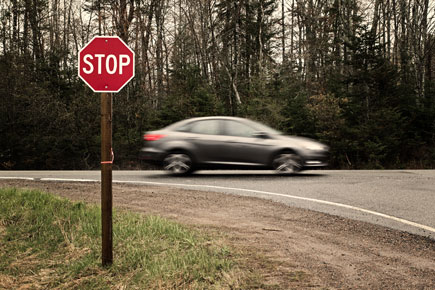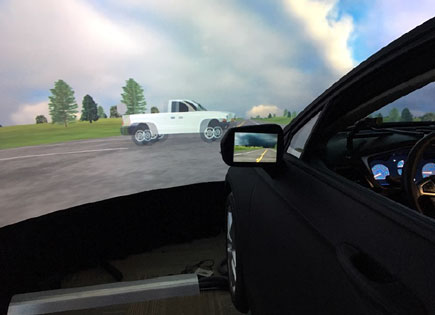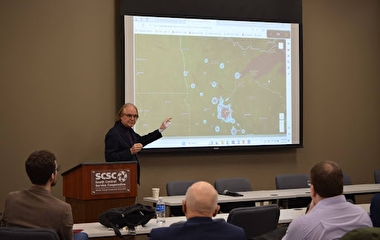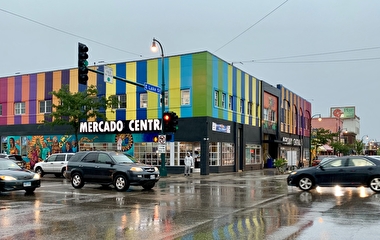To improve safety at often-dangerous rural road intersections, U of M researchers have investigated drivers’ ability to judge traffic speed and gaps between cars at varying sight distances. Using a state-of-the-art driving simulator, the researchers showed that 1,000 feet of sight distance allows drivers to make better crossing decisions.
“We’ve known that sight distances were factors in rural intersection crashes,” says Tracey von Bargen, county engineer for Grant County, Minnesota. “This study gave us the hard data showing how long sight distances should be to allow drivers sufficient time and space at rural thru-stop intersections.” (Thru-stop intersections are those at which a highway crosses a minor road controlled by a stop sign.)
The need for this project was pressing because four-way intersections carry inherent safety risks for drivers. From 2008 to 2012, nearly 42 percent of severe crashes occurring at Minnesota intersections resulted in serious injuries and fatalities, and crashes are often most severe at unsignalized rural intersections.
“Drivers on minor roads seeking to cross must determine when traffic gaps are sufficient to cross and can misjudge the time-to-collision,” says Nichole Morris, director of the U of M’s HumanFIRST Laboratory. “Limited visibility has been associated with drivers choosing insufficient gaps, so we wanted to determine the optimal sight distance at four-way intersections. This will maximize driver safety, reduce injuries, and save lives while potentially reducing unnecessary clearing of trees and brush at intersections.”
The driving simulator at the HumanFIRST Lab was an essential part of this study. The Realtime Technologies simulator consists of a 2013 Ford Fusion cab with realistic controls and the latest-generation simulation software and projection hardware, making it possible to generate complex environments that engage the driver’s senses to create a realistic simulated experience.
Researchers began by developing nine simulations of prototypical Minnesota rural roads that incorporated wooded areas and shoulders to examine drivers’ time-to-collision judgments for crossing. In addition, they developed a 19-mile mainline roadway with 18 minor thru-stop intersections. The simulations were then rigorously tested for validity by state, county, and research engineers familiar with rural intersections.
Next, 36 drivers were selected to participate in the simulated driving trials. For the time-to-collision trial, drivers waited at nine simulated intersections with varying sight distances and speeds of crossing vehicles and were asked to press the gas pedal when they determined it was safe to cross. For the mainline trial, participants drove the 19-mile mainline road segments and were presented with cars at minor road thru-stops with variable sight distances; the cars either stopped or intruded into the intersection. After the trials, participants reported on their perceived cognitive demand at the crossings.
Study results show that 400- and 600-foot sight distances are insufficient for drivers to make good crossing decisions. The 1,000-foot sight distance and slower speeds (55 mph) allowed drivers to judge time-to-collision more effectively and respond to cars at minor thru-stops intruding into the mainline. “This means that drivers could effectively respond to a car running a stop sign—often a catastrophic crash scenario,” Morris says.
Finally, researchers discovered that when mainline drivers noticed a thru-stop car waiting closer to the intersection, they reduced speed more than for a car stopped farther back. Therefore, moving the stop bar on minor roads closer to the intersection could both increase the sight distance for the waiting driver and slow driver speeds on the mainline—an inexpensive change with potentially significant benefits.
“Agencies could use the 1,000-foot sight distance and our other findings for guidance,” Morris says. The project was funded by the Minnesota Local Road Research Board.




